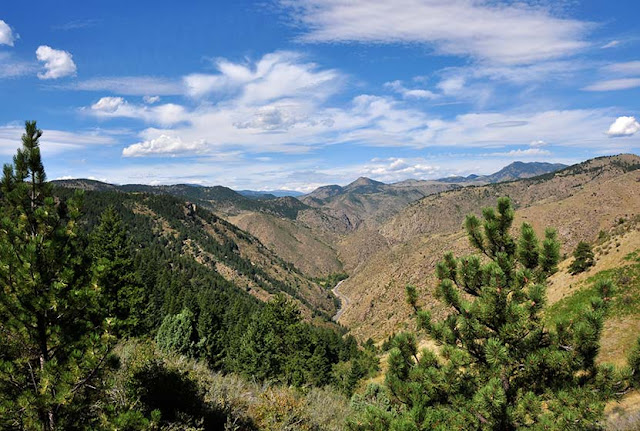STAIRWAY TO HEAVEN
"There's a feeling I get ...When I look to the west
And my spirit is crying for leaving"
... Led Zepplen, 'Stairway to Heaven'
It was overcast the day we left Zion National Park and the first time without sun since we arrived eight days earlier. That helped ease the discomfort of leaving our second most favorite spring destination. The next stretch of our trip incorporated new destinations and experiences, starting with spending a few days in Escalante, Utah visiting Grand Staircase National Monument and Bryce Canyon. We didn't mind that the cloudy weather followed us since we were going to be travelling anyway. What we didn’t expect was to be caught in a snow storm.
About two hours into our four hour journey, two things became apparent: it was raining a lot and the roads were getting narrower and windy as we ascended into the mountains. Rain soon turned to sleet and then snow as we finally reached the summit at 8,000 ft. Don't forget we were in a 30 ft motor home pulling a car behind on a trailer. Doug's experience driving a truck in the army, along with spending snowy winters living near Chicago sure came in handy that day!
Once we arrived in Escalante, we looked for a natural formation shaped like a staircase, but there was none. In fact, there really weren’t any dramatic cliffs or anything around us. So where was this “Staircase” and what was so grand about it? After some research we solved the mystery. Gotta love the internet!
The Grand Staircase refers to a sequence of sedimentary rock layers that stretch from Bryce Canyon National Park and Grand Staircase-Escalante National Monument, through Zion National Park, and into the Grand Canyon National Park. In the 1870s, geologist Clarence Dutton first conceptualized this region as a huge stairway ascending out of the bottom of the Grand Canyon northward with the cliff edge of each layer forming giant steps. The Grand Staircase is not readily visible because it covers over 1,000,000 acres. The “steps” of the staircase were formed as the sedimentary layers were pushed upwards by plate tectonics. Rivers, such as the Colorado and Virgin, eroded the landscape to form the deep canyons. The exposed layers range from 100 million years old to 600 million years old and contain a continuous rock and fossil record of earth history like no other place on earth.
Doug was able to capture some of the layers of brilliant color:
Escalante Steps
"Colors are the smiles of nature." - Leigh Hunt
Bryce Canyon is a one-of-a-kind formation. Here, the eroding force of frost and the dissolving power of rainwater have shaped the crimson and orange limestone rock into bizarre shapes including slot canyons, windows, fins, and spires called "hoodoos." Experiencing this magical wonderland is like being on another planet.Bryce Canyon is also a painter's paradise. Too bad we were only there one day.
Hoodoos, Bryce Canyon
"Dinosaurs - they're not extinct, they're just hiding."- Anonymous
Next, it was time to check off one of Sue’s “bucket list” items by visiting Dinosaur National Monument in Vernal, Utah. Expecting to see the typical display of assembled dinosaur skeletons, we were once again pleasantly surprised by what we learned and experienced.In 1909, paleontologist Earl Douglas was searching for fossils for the Carnegie Museum when he discovered an entire rock formation layered with prehistoric plant and animal fossils. Further excavation revealed multiple layers of dinosaur fossils, indicating that this location may have once been one a downstream bottleneck where carcasses accumulated and decayed after a flood. Many of these fossils formed complete skeletons and were removed and shipped to various museums around the country where they remain on display today.
In 1915, Dinosaur National Monument was established and the remaining quarry wall was preserved with additional dinosaur fossils still intact. This is the only intact preservation site that exists. Fragmented fossils are so prevalent in the area surrounding the quarry that we were even able to see them in rocks on the hillside outside the quarry.























Absolutely amazing post. Thanks for the virtual trip. Perhaps i will be inspired to get up there but I am happy to have missed driving in a snow storm. Thanks again.
ReplyDelete